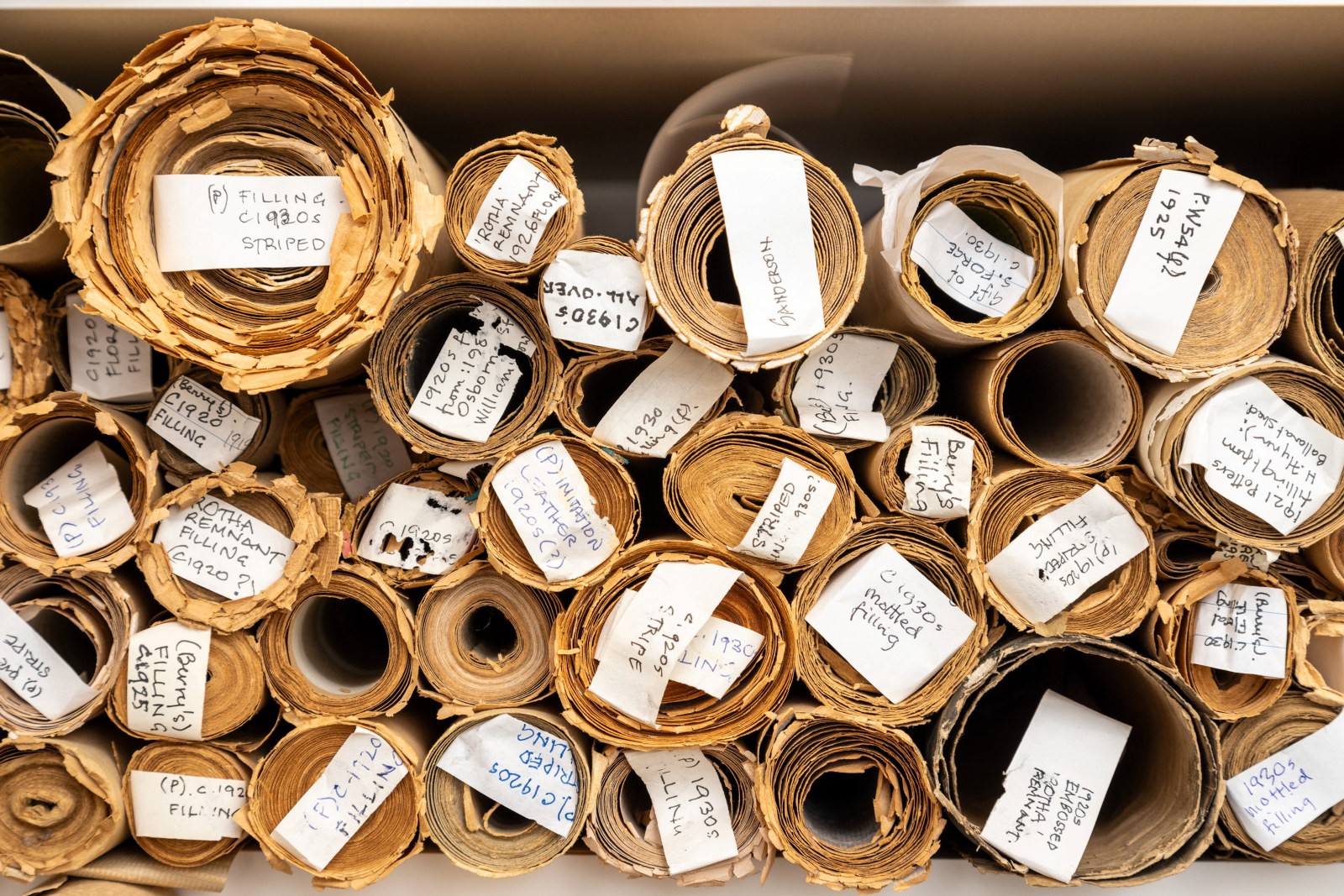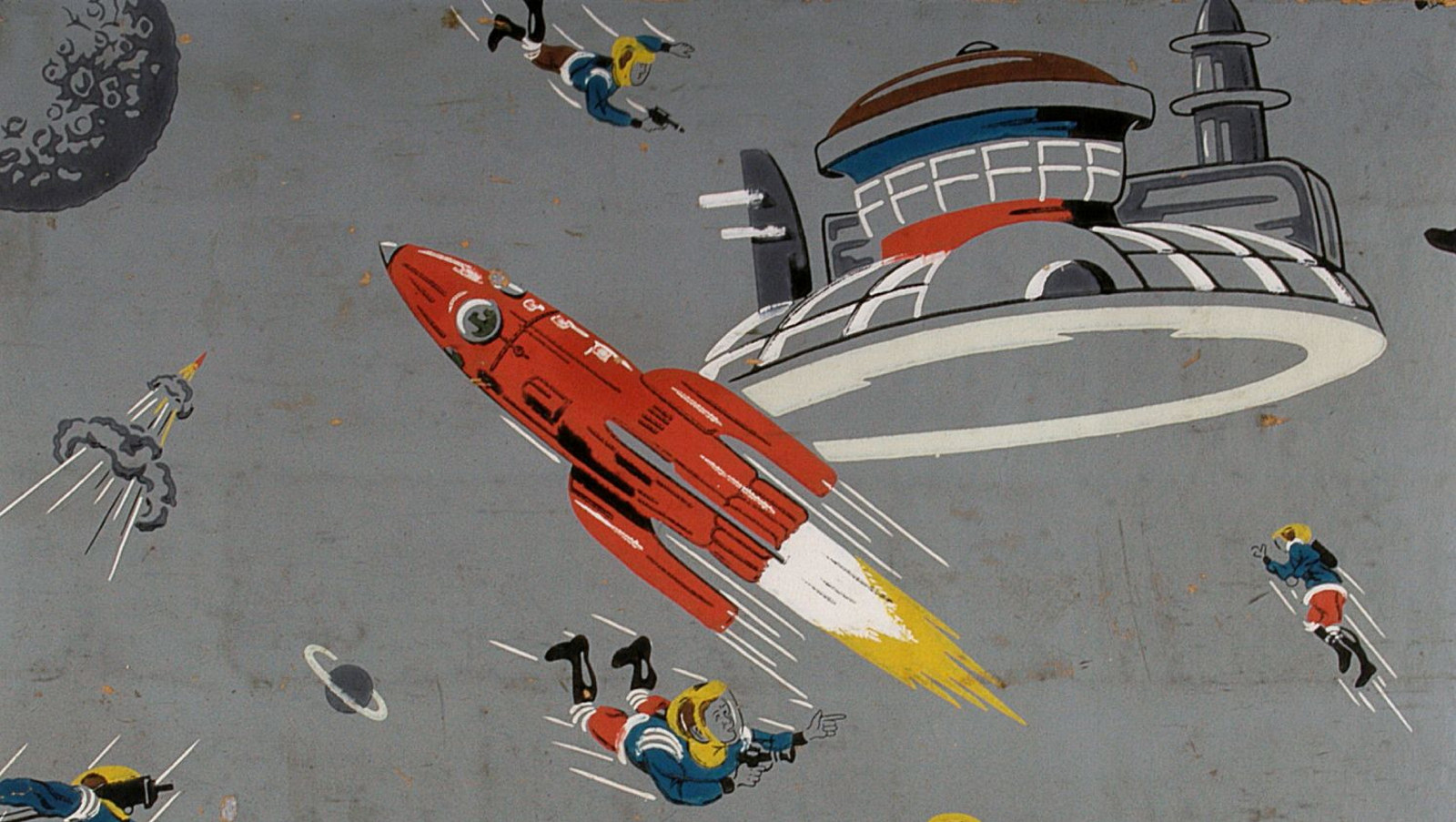Wallpaper printing rollers: from machine printing to 3D capture
In December 2022, Phyllis Murphy AM generously donated to the Caroline Simpson Library more than 3,000 wallpaper samples she had collected with her late husband, John Murphy (1920–2004), over almost 40 years. While the bulk of the donation consists of wallpaper rolls, lengths and sample books, it also includes two printing rollers used by Canadian Wallpaper Manufacturers Ltd between 1927 and 1950. The rollers may have stopped turning long ago, but thanks to 3D-capture and -printing technology their designs can now be seen again and appreciated in new ways.
Machine printing
The earliest wallpapers in MHNSW’s collection – the largest repository of historical wallpapers in Australia – date from the 1840s. This coincides with the beginning of machine printing of wallpapers in England, Australia’s primary source of wallpaper for many decades.
Before the 1840s most wallpaper was block printed. Woodblocks were carved with designs by hand, manually inked and impressed onto paper. This labour-intensive process meant that wallpaper was expensive to produce and available only to the well-off. The advent of machine printing – where a continuous length of paper was drawn over a large drum, around which were smaller rollers that printed in different colours – transformed the industry. A decade after the first machine-printed wallpapers went on sale, the jurors of the Great Exhibition of 1851 in London remarked on the innovation:
Paper-hangings have been printed in England by means of hand machines for many years … It was not until about ten years since [that] machine printing was fully introduced, and this was done by Messrs. Potter, of Darwen [a wallpaper manufacturer was started by the Potter family in Darwen, Lancashire, in 1839] … who, by means of steam-power, artificial drying, and an endless roll of paper, were enabled to produce patterns with good effect by surface-roller printing in several colours.¹
Machine printing of wallpaper drastically reduced prices, enabling even the most humble households to paper their walls and regularly repaper to follow international design trends (as seen in a ‘sandwich’ of many layers of wallpaper retrieved from a small worker’s cottage in Pyrmont, Sydney, with papers dating from the early 1840s to the mid-1870s). Handmade wallpapers produced by block printing continued to be available, but they were now premium products, far surpassed in volume by machine-printed wallpapers.
The John and Phyllis Murphy Collection reflects the widespread adoption of wallpaper in Australia from the mid-19th century following mechanisation. Although the rollers donated by the Murphys were used in the early to mid-20th century, the technique of roller printing remained essentially the same as when the technology was developed some 100 years earlier.
From printer to printed
In 2024, the two rollers were used in a whole new form of printing technology – 3D printing. Dean Scott, Senior 3D Designer at MHNSW, used a process called photogrammetry to create 3D models of the rollers, which were rotated on a turntable while approximately 300 photographs were taken from all sides at different angles. The photos were processed to create digital models overlaid with a photographic texture to create accurate 3D reproductions. The digital models are valuable tools that enable audiences anywhere in the world to appreciate and interact with these objects.
You can view the photogrammetric reproduction of the wallpaper roller, combining the 3D model and photographic texture, below or by clicking here to open in a new window.
The models were then 3D printed (at a reduced scale), which enabled us to print their designs again without damaging them. The replica rollers were inked using stamp pads and rolled onto paper, allowing us to re-create the designs of each roller on paper. Originally, a series of rollers were used for each wallpaper design to add different colours and design elements. The two rollers in the Murphy collection have different outlines, the first with a dense, flowing foliage design that would have been used as ‘filling’ (wallpaper that covers the main area of the wall). The other roller design has sparser sprigs of foliage and is mirrored in the centre, intended to be cut into two lengths and used as a frieze (wallpaper that is hung as a decorative band around the top of a wall). This discovery means that although the rollers produce different outlines, they may have been designed together to create a wallpaper filling and frieze in a matching set.
3D capturing objects in this way allows MHNSW to care for our sites and collections by documenting them at a given moment and in context. It allows our audiences to interact with them online and also physically handle 3D-printed facsimiles of collection objects usually out of reach for their conservation. And it encourages us to ask questions of collection objects that were more difficult, or impossible, to ask before. Wallpaper printing rollers such as the two in the John and Phyllis Murphy Collection were a key development in manufacturing technology that allowed many Australians to experience the beauty of wallpaper in their homes. Today, 3D documentation of these items exemplifies how new technology supports research into, and conservation and enjoyment of, our collections.
Note
1. ‘Paper-hangings’, Exhibition of the works of industry of all nations 1851: reports by the juries on the subjects in the thirty classes into which the exhibition was divided, William Clowes & Sons, London, 1852, p547.
From the collection

Past exhibition
A Generous Gift: The John and Phyllis Murphy Collection
Our current library display features an array of colourful and evocative historical wallpapers from the John and Phyllis Murphy Collection
Tuesday 29 October
Published on
Related
Browse all
Wallpaper
Beyond the wallpaper: the life and work of Phyllis and John Murphy
A significant donation of more than 3,000 wallpaper samples to the Caroline Simpson Library reflects just one facet of the remarkable careers of Phyllis and John Murphy, partners in life, architecture and heritage conservation

Wallpaper
Wall to wall: a marvellous wallpaper collection
A remarkable donation of over 3,000 wallpaper samples by John and Phyllis Murphy adds to our existing collection to form Australia’s largest repository of historic wallpapers

Wallpaper
Sci-fi wallpaper (and other designs for children)
We dug deep into our collections and found wonderfully whimsical wallpaper, designed for children’s bedroom walls

